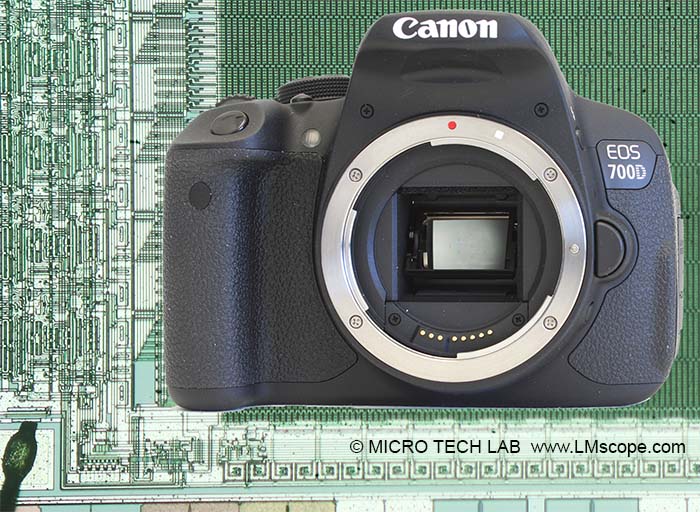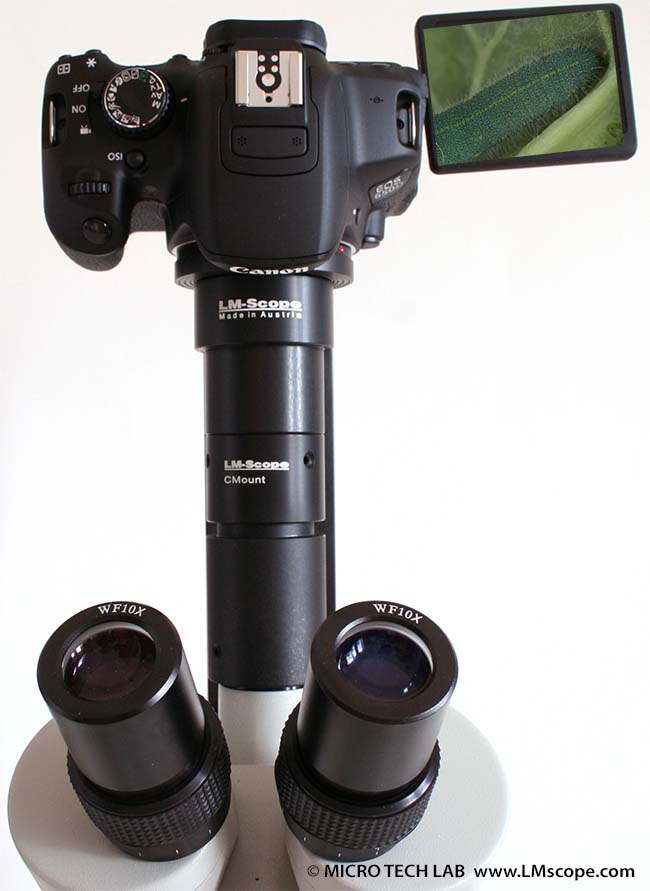

Using the Canon EOS 700D (Canon Rebel T5i) for photographic work on the microscope
The latest version of the Canon EOS entry-level range, the Canon EOS 700D (Rebel T5i), has already been on the market for several months. Since the two previous models, the Canon EOS 650D (Rebel T4i) and the EOS 600D (Rebel T3i), are very widespread in microscopy, we naturally wanted to see what innovations the Canon EOS 700D (Rebel T5i) had to offer

To get straight to the point: our hopes for big improvements in terms of higher pixel numbers or greater light sensitivity were not fulfilled. But looking at it from Canon’s perspective, we have to admit that there is absolutely no reason for them to change a tried and tested, successful model.
At first glance, the most obvious difference to the Canon EOS 650D (Rebel T4i) and the Canon EOS 600D (Rebel T3i) is the housing material. The camera appears to be of a considerably higher quality and offers a much better “grip”. At 525 grams, the weight is still somewhat less than the previous models.
The Canon EOS 700D (Rebel T5i) features the same tried and tested sensor (CMOS in APS-C size, 18 megapixels) as the previous models. Additionally, it has a moveable display, which is also touch sensitive. However, the touch function is not of critical importance in microscopy, as the camera should be controlled from a computer anyway in order to avoid vibrations.

In standard mode, the ISO sensitivity can be adjusted from 100 to 12,800; in manual mode, ISO can be expanded to up to 25,600.
Of note, the video function of the Canon EOS 700D (Rebel T5i) has been optimised to full HD resolution (1920 x 1080), supporting a frame rate of up to 30 frames per second.
It goes without saying that the EOS 700D (Rebel T5i) also has a magnification function in Live View mode and can be controlled via computer, iPad or smartphone using the Canon Utility software. As with all Canon models, this software is included in the purchase price of the camera.

Another very practical aspect is that the auto shut-off feature can be deactivated. This is especially useful for lectures, as it is no longer necessary to repeatedly turn the Live View mode on again.
In summary it can be said that the Canon EOS 700D (Rebel T5i), like the Canon EOS 650D (Rebel T4i), has all of the important standard functions needed for photomicrography. It is very easy to attach the camera to a microscope using the LM digital microscope adapters. Our adapter solutions are available for all standard connections, such as 23.2 mm and 30 mm eyepiece tubes, and for phototubes with standard C-mount connections. In addition, we offer special solutions for a multitude of stereo and laboratory microscopes, such as the Zeiss Axioskop, Axiolab, Stemi, Leica DM series, Leica S and M series, Leitz Dialux, Ergolux, Metallux, Olympus BX and SZ series, Nikon Eclipse series, Alphaphot, Labophot, SMZ series, etc.

When playing around with the camera, we noticed that with the HDMI output in HD quality, the image can also be displayed across the entire screen of the monitor without showing any additional information. By pressing the info button, the camera information is hidden and the Live View video window is reduced in size. This makes it possible to use the whole of the screen in “full screen” mode.
Conclusion: The Canon EOS 700D (Rebel T5i) has an excellent price-performance ratio and meets the challenges of photomicrography extremely well. It is equipped with all of the important functions and can be easily controlled via the computer. However, there are no significant innovations compared to the previous models.
16.12.2013
New LM Digital Adapter for: Canon EOS R3 / Canon EOS R6 Mark II / Canon EOS R8 / Canon EOS R5 II / Canon EOS R5 / Canon EOS R6 / Canon EOS R / Canon EOS Ra (Astro) / Canon EOS RP / Canon EOS R7 / Canon EOS R10 / Canon EOS 1D X Mark III / Canon EOS 1D X Mark II / Canon EOS R100 / Canon EOS 1D X / Canon EOS 90D / Canon EOS 5D Mark IV / Canon EOS 6D Mark II / Canon EOS M6 Mark II / Canon EOS 250D / Canon EOS 850D / Rebel T8i / Canon EOS 6D / Canon EOS M200 / Canon EOS 5DS R ( without low-pass filter) / Canon EOS 80D / Canon EOS M50 Mark II / Canon EOS 5DS / Canon EOS M50 / Canon EOS 70D / Canon EOS 200D / Canon EOS 800D / Rebel T7i / Canon EOS 77D / Canon EOS 5D Mark III / Canon EOS 60D / Canon EOS 750D / Rebel T6i / Canon EOS 760D / Rebel T6s / Canon EOS 5D Mark II / Canon EOS 1D Mark IV / Canon EOS 7D Mark II / Canon EOS 600D / Rebel T3i / Canon EOS 650D / Rebel T4i / Canon EOS 700D / Rebel T5i / Canon EOS 2000D / Rebel T7 / Canon EOS 7D / Canon EOS 550D / Rebel T2i / Kiss X4 Digital / Canon EOS 1300D / EOS Rebel T6 / Canon EOS 4000D / Canon EOS 100D / Canon EOS 50D / Canon EOS 1200D / EOS Rebel T5 / EOS Kiss X70 / Canon EOS 1100D / Rebel T3 /